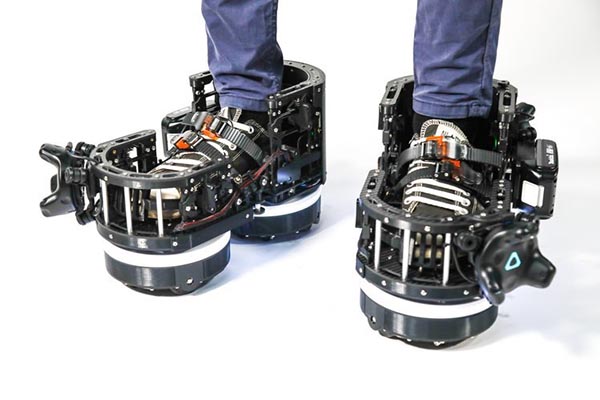Your Friday Slicing Open a Giant Jawbreaker
Old Words
Via Laughing Squid, Harrison Holt of The Generalist Papers presents a brief but thorough animated explanation of the history of the English language.
The history takes Holt back to the age of the Anglo-Saxons where Old English was spoken. It then combined with Danish and Norman French to become Middle English. When the Great Vowel Shift took place in the 15th century, modern English was developed. This particular form of English continued to evolve up through present day. And it will continue to do so.
Renaissance Fair
A lot of folks call me a "Renaissance Man." Mostly because I look about 700 years old.
— Ted Travelstead (@trumpetcake) February 27, 2022
Old Wordle
Via Boing Boing, Squirrel Monkey—whose stock in trade is recasting modern apps as if they existed in decades past—takes a look at what Wordle would look like if it had existed in the 1980s.
Work It Out
Word of the day: GYMTIMIDATION (neologism) - the nervousness or anxiety you feel about heading back to the gym after a long time away
— Quite Interesting (@qikipedia) February 24, 2022
Better Reading Through Chemistry
There is no smell as intoxicating as that of old books. The moment one steps inside a library or antiquarian bookstore, the pervasive aroma is transporting. And new books have their own distinctive, appealing aroma, as well. Why would that be? Obviously, the chemical constituents of books are the reason. But which chemicals? As it turns out, there has been a fair amount of research on the “old book smell” but very little on new books. Compound Interest, a chemistry site, explains:
As far as the smell of new books goes, it’s actually quite difficult to pinpoint specific compounds, for a number of reasons. Firstly, there seems to be a scarcity of scientific research that’s been carried out on the subject – to be fair, it’s understandable why it might not exactly be high up on the priority list. Secondly, the variation in the chemicals used to manufacture books also means that it’s an aroma that will vary from book to book. Add to this the fact that there are literally hundreds of compounds involved, and it becomes clearer why it evades attribution to a small selection of chemicals.
It’s likely that the bulk of ‘new book smell’ can be put down to three main sources: the paper itself (and the chemicals used in its manufacture), the inks used to print the book, and the adhesives used in the book-binding process.
Fair enough. But where there has been substantial research is old books, and for good reason.
it’s been investigated as a potential method for assessing the condition of old books, by monitoring the concentrations of different organic compounds that they give off. As a result, we can be a little more certain on some of the many compounds that contribute to the smell.
Generally, it is the chemical breakdown of compounds within paper that leads to the production of ‘old book smell’. Paper contains, amongst other chemicals, cellulose, and smaller amounts of lignin – much less in more modern books than in books from more than one hundred years ago. Both of these originate from the trees the paper is made from; finer papers will contain much less lignin than, for example, newsprint. In trees, lignin helps bind cellulose fibres together, keeping the wood stiff; it’s also responsible for old paper’s yellowing with age, as oxidation reactions cause it to break down into acids, which then help break down cellulose.

Licensed under a Creative Commons Attribution-NonCommercial-NoDerivatives 4.0 International License. See the site’s content usage guidelines.
Hot Dog
picture them peacefully grazing in the pasture pic.twitter.com/ADV9JfQ7jl
— Bill Corbett (@BillCorbett) February 28, 2022
Skin Deep
Speaking of old books, one aroma we would not find all that enticing would be human flesh. Which brings us to the latest installment of Ask a Mortician, “Were Books Ever Bound in Human Skin?” Disturbingly enough, yes. Caitlin Doughty looks at the myths and the reality of skin-bound books. Also, what are best practices for the handling and preservation of such books?
Dishwasher Safe
I thought of more than 13 just looking around my office.
— J. Elvis Weinstein (@JElvisWeinstein) March 2, 2022
Short Schrift
If you’ve ever taken a road trip in Germany and played the license plate game, you may not have realized the history behind the typeface used on German license plates. Called FE-Schrift, it was designed by German type designer Karlgeorg Hoefer and began to be used for license plates in the 1990s. It was created as a replacement for the previous typeface, DIN (Deutsches Institut für Normung) 1451.

Image by Wassim Chouak on Unsplash
DIN 1451 was a perfectly fine face; it was easy to read, and in fact was also used for road signs and other industrial uses. Unfortunately, it was also easy to modify and forge—which became a strategy for terrorists in the 1970s and 80s when Germany was still divided into East and West. Says Core77:
Baader-Meinhof Gang, a/k/a the Red Army Faction…carried out terrorist-style assassinations, bombings and kidnappings. They robbed banks for funding and tended to get into shootouts with the police. To avoid detection, they often used license plates that they modified.
Hence the creation of FE-Schrift, which is short for Fälschungserschwerende Schrift, or “anti-counterfeiting font,” designed specifically to thwart forgery. How?
As an example, with your average sans serif font the letter “P” is easy to change to “R,” “B” is easy to change to “3,” and “F” is easy to change to “E.” So let’s say your license plate contains “PBF,” and you want to change it to “R3E.” If you try that with FE-Schrift, at first glance it seems do-able:

Image by Stybn, CC BY-SA 3.0
However, when you stack up the fake (red) “R3E” with the real way it’d be printed in FE-Schrift, the differences become apparent:

Image by Stybn, CC BY-SA 3.0
The casual onlooker might not be able to spot the fake, but it was good enough for the primitive license-plate-reading cameras and software Germany was using at the time of its introduction.
FE-Schrift became Germany’s official license plate typeface in 2000.
All Maps Amazing and Terrible, Part the Infinity
An image of GPS tracking of multiple wolves in six different packs around Voyageurs National Park shows how much the wolf packs avoid each other's range. #Map #Maps #Amazingmaps #GPS #MapPorn
— Amazing Maps™ (@amazingmap) December 9, 2018
Source: https://t.co/VWGrb0dYWe pic.twitter.com/Dn8RfPHqXA
Europe but if Europe colonised it pic.twitter.com/J3qLuyNH7P
— Terrible Maps (@TerribleMaps) February 21, 2022
Too-Fast Fashion
As problematic as “fast fashion” can be for the environment, there is a phenomenon we can call “too-fast fashion” that is problematic for designers. Namely, the problem of knockoffs—or ripoffs, basically. The trouble is, fashion designs can’t be copyrighted or trademarked, so there is kind of an honor system whereby designers don’t rip each other off. And you can imagine how well that works. Says The Verge:
Fast-fashion companies like Cider and Shein are known to regularly rip off designs from small creators. Usually, there are very few consequences, because most clothing items cannot be protected under American copyright laws.
This means that when a small designer like Crochet Bao, who asked to be identified by the name of her online store, has her design imitated, the only thing she can do is post about it online and hope people see that the design is actually hers.
Knitwear has taken over the industry—and given the effort it takes to make knits, a knockoff is even more egregious.
When the knitwear designer Crochet Bao posted her latest creation to Instagram last May, fans fawned over what they saw: a red and white cardigan with gingham-checked sleeves, chunky accents, and big strawberries patterned across the body. “A lot of people were DMing me and asking for a pattern, but some people were willing to pay for it as well,” Crochet Bao said.
If someone is interested in the cardigan, they can go to her Etsy store to buy crochet pattern instructions for $11 or a custom-made cardigan for $195.
Or, they can go to online clothing retailer Cider and buy a knockoff cardigan with an almost identical design for $32 — which isn’t surprising to the full-time designer, who found out about the listing after a follower messaged her.
Crochet Bao spent three months laboring over her cardigan design, making prototypes to ensure the instructions were size-inclusive, creating step-by-step videos, and having multiple people test the design. Ultimately, every time someone orders a cardigan, it takes 18 hours to crochet it by hand.
“After all that work, for someone to just take it and then sell for like one-eighth of the price or even less, is just insane,” the 25-year old Etsy seller said
These knockoffs also subvert the move to make garments and apparel unique, sustainable items “that promote slow, ethical fashion practices.” Ultimately, it comes down to consumers recognizing knockoff sites and being willing to pay a few bucks more to support designers—and ethical design.
Eight Arms to Hold You
I can see this catching on. https://t.co/uyJ65X2Zps
— Michael McKean (@MJMcKean) February 25, 2022
Graphene Has Star Power
Was it a good week for graphene news? It’s always a good week for graphene news! Whilst watching a rerun of the TV show NCIS (“Up In Smoke,” first aired May 8, 2012), we were excited to see that a certain substance played a major role in the episode. The plot went like this:
When a bug is found in Probationary Agent Ned Dorneget’s tooth, the team goes full force in the effort to arrest Harper Dearing. The team receives multiple suspects, one of which is Dorneget’s dentist, which ends up leading to an MTAC call from Dearing himself.
The team marveled at the power source for the bug, which turned out to be…graphene!
A patent on piezoelectric graphene to character Harper Dearing (played by Richard Schiff) explains the power source for a bug implanted in a tooth of Probationary Agent Ned Dorneget. The NCIS team learns this after the team marvels at the cleverness of the power source and suspects there is a patent is involved. Abby does a patent search to verify the “it must be patented” theory, finds the patent (shown on video), but her search at the USPTO is flagged by the DoD and Samantha Ryan shows up.
Turns out there is an actual patent application called “PIEZOELECTRIC NANOWIRE STRUCTURE AND ELECTRONIC DEVICE INCLUDING THE SAME to Samsung (US 20110101315 ), published May 5, 2011, which does identify graphene as one of the conducting materials.
The episode was 10 years ago—we would have thought that graphene would have gotten its own series by now.
Looking Into It
Disgusted by people sharing these intimate nudes of me online. https://t.co/4CjrXUXcpW
— Aisling Bea (@WeeMissBea) January 4, 2022
These Boots Were Made for VRin’
One of the challenges to developing realistic and completely immersive virtual reality (VR) experiences has been how to simulate walking. Some potential solutions have included the Infinadeck, an omnidirectional treadmill, and wearable Cybershoes, although they require the user to sit. Now, via Core77, Ekto VR presents the Ekto One Simulator Boots.

Essentially, they are kind of like roller skates, with wheels inside that attempt to move you back to your original position as you walk. Seems kind of dangerous…
Bear Necessities
Detective Goldie Locke declined to comment. https://t.co/o4lXcUtj1E
— Charles P. Pierce (@CharlesPPierce) February 26, 2022
Augmented Reality
Jason Barnes is a multi-instrumentalist who specializes in playing the drums. One day, at his job at a restaurant, a freak electrical accident sent 22,000 volts through him, frying his right hand, which became unsalvageable, and his arm had to be amputated below the elbow. He was naturally despondent over not being able to play the drums again, until his drum teacher introduced him to Gil Weinberg, the founding director of the Georgia Tech Center for Music Technology, who was an authority on artificial intelligence. The result: an AI-controlled bionic hand that can play the drums. Via Reasons to Be Cheerful:
The bionic arm includes two drumsticks — one that translates Barnes’s muscle movements and a second, autonomous stick that has been “trained” by machine learning. After being fed many hours of improvisations of jazz greats such as John Coltrane and Thelonious Monk, the A.I. drumstick can improvise on its own. “It’s almost like having a second, bionic drummer in the band,” Barnes half-jokes. With his A.I. arm, Barnes even made it into the Guinness Book of World Records as the world’s fastest drummer, achieving 20 hits per second with each stick.
Nicknamed the “cyborg drummer,” he is now a full-time performer, producer, and songwriter, appearing internationally under the stage name Cybrnetx.
Weinberg’s work has applications far beyond music.
Weinberg is convinced that the astonishing progress in bionics opens enormous possibilities for other clients, for instance, people who have suffered traumatic brain injuries and need to relearn movements. A different team at Georgia Tech has invented a glove that teaches people to play the piano or learn Braille within a few hours (it usually takes several months) using haptic passive learning. “You need incredible precision and dexterity to make music,” says Weinberg, “so when we make it possible for them to play the piano, they can do pretty much everything else such as typing on a keyboard or doing mechanical work.”
What the Beep?
Let’s play a fun game! What’s That Beeping in My House?
— Brenna Ehrlich - KILLING TIME out March 8th! (@BrennaEhrlich) January 23, 2022
When You Wish Upon a Satellite
Have you ever wished upon a star only to find out it was a satellite? Does wishing on space hardware invalidate the wish? Regardless, never make that mistake again by logging into Heavens-Above, a website developed and maintained by Chris Peat dedicated to helping people observe and track satellites orbiting the Earth without the need for binoculars or a telescopes. You can set your location and see what is in the sky above you at the moment.

Heavens-Above also provides live tracking of the International Space Station (ISS). It’s pretty neat!
Pets
Medical Experts Hopeful That Gene Editing Will Soon Allow Sick Kids To Have Super Weird Pets https://t.co/gl1ftn3Hmv pic.twitter.com/OvylpEyGqy
— The Onion (@TheOnion) February 27, 2022
Hello, Mr. Chips
Smithsonian magazine recently had an article chronicling the origin of perhaps our best-loved snack food: the potato chip. Many people have claimed to have invented the chip, but perhaps the best-known origin story takes place in 19th-century Saratoga Springs, N.Y., where George Crum (né George Speck) was a chef at Moon’s Lake House, just south of the city on Saratoga Lake.
As the story goes, one day in 1853, the railroad and shipping magnate Cornelius Vanderbilt was eating at Moon’s when he ordered his fried potatoes be returned to the kitchen because they were too thick.
(It’s hard to imagine why workers are fleeing the restaurant industry. We continue.)
Furious with such a fussy eater, Crum sliced some potatoes as slenderly as he could, fried them to a crisp and sent them out to Vanderbilt as a prank. Rather than take the gesture as an insult, Vanderbilt was overjoyed.
Other diners starting asking for the chips, and not long afterward Crum opened his own restaurant, where a basket of chips sat on every table. Soon, their popularity spread beyond the Saratoga region—and far beyond Upstate New York.
However, food historians acknowledge other origins.
The earliest known recipe for chips dates to 1817, when an English doctor named William Kitchiner published The Cook’s Oracle, a cookbook that included a recipe for “potatoes fried in slices or shavings.” And in July 1849, four years before Crum supposedly dissed Vanderbilt, a New York Herald reporter noted the work of “Eliza,” also, curiously, a cook in Saratoga Springs, whose “potato frying reputation” had become “one of the prominent matters of remark at Saratoga.”
Still, it’s Crum who is generally held to be the father of the potato chip, and you can still buy his original recipe “Saratoga Chips” today.
His Master’s Voice
The first YouTube pet video before there were YouTube pet videos...nothing ever really changes.... https://t.co/VTtntxtdxB
— J. Michael Straczynski (@straczynski) January 2, 2022
Yes Yes
When in Salem, Mass., touring the various witch-related tourist sites, be sure to visit the Salem Witch Board Museum, dedicated entirely to Ouija boards. And there are more of them than you would think. From the Boston Globe:
[John] Kozik owns the Salem Witch Board Museum on Essex Street in Salem, a testament to his 15-year pursuit collecting Ouija. The two-year-old museum houses a third of Kozik’s personal collection of talking boards — around 100 at any given time — an obsession that started with his grandmother. All in all, the museum collection totals 300 to 500 boards.
…The Salem Witch Board Museum is a speakeasy of sorts, and patrons have to enter through the gift shop, Remember Salem, to access it. Inside, the 500 square-foot museum is ordered chronologically, detailing the history of talking boards from the Spiritualist movement in the 1800s to today’s pop culture references in a self-guided tour. Some boards hang on the walls, but some along with planchettes are encased in clear displays. And in its own special spot is Kozik’s grandmother’s original board, the one that started it all.
Names People Play
Your name is your first name plus your last name. I'll go first: Josh Malina.
— (((Joshua Malina))) (@JoshMalina) January 18, 2022
This Week in Printing, Publishing, and Media History
February 28
1683: French entomologist and academic René Antoine Ferchault de Réaumur born. After observing wasps building their nests, Réaumur was the first to propose making paper out of wood.
1827: The Baltimore and Ohio Railroad is incorporated, becoming the first railroad in America offering commercial transportation of both people and freight.
1935: DuPont scientist Wallace Carothers invents nylon.
1939: The erroneous word “dord” is discovered in the Webster's New International Dictionary, Second Edition, prompting an investigation.
1940: Basketball is televised for the first time (Fordham University vs. the University of Pittsburgh in Madison Square Garden).
1944: English graphic designer and cofounder of Hipgnosis Storm Thorgerson born.
1954: The first color television sets using the NTSC standard are offered for sale to the general public.
1970: American journalist, author, and accordion player Daniel Handler born. Under the name Lemony Snicket, he is the author of the children’s book series A Series of Unfortunate Events.
1983: The final episode of M*A*S*H airs, with almost 106 million viewers. It still holds the record for the highest viewership of a season finale.
March 1
1790: The first United States census is authorized.
1869: Dmitri Mendeleev finishes his design of the first periodic table of elements and sends it for publishing.
An alternative version of the periodic table, as designed by Theodor Benfey in 1964. pic.twitter.com/RTWgQ4jQK8
— Quite Interesting (@qikipedia) February 27, 2019
1872: Yellowstone National Park is established as the world’s first national park.
1873: E. Remington and Sons in Ilion, N.Y., begins production of the first practical typewriter.
1893: Electrical engineer Nikola Tesla gives the first public demonstration of radio in St. Louis, Mo.
1896: Henri Becquerel discovers radioactive decay.
1914: American novelist and literary critic Ralph Ellison born.
1917: American poet Robert Lowell born.
1917: The Zimmermann Telegram is reprinted in newspapers across the United States after the U.S. government releases its unencrypted text.
1922: American publisher and founder of MAD Magazine William Gaines born.
1998: Titanic became the first film to gross over $1 billion worldwide. (It is worth checking out this site that adjusts the highest-grossing movies for inflation.)
2006: English-language Wikipedia reaches its one millionth article, Jordanhill railway station.
March 2
1545: English diplomat and scholar, founder of the Bodleian Library Thomas Bodley born.
1717: The Loves of Mars and Venus is the first ballet performed in England.
1791: Long-distance communication speeds up with the unveiling of a semaphore machine in Paris.
1904: American children's book writer, poet, and illustrator Dr. Seuss (né Theodor Seuss Geisel) born.
1930: English novelist, poet, playwright, and critic D. H. Lawrence dies (b. 1885).
1933: The film King Kong opens at New York's Radio City Music Hall.
1942: American novelist and screenwriter John Irving born.
1942: American singer-songwriter, guitarist, producer, and actor Lou Reed born. Just like Sister Ray said.
1982: American philosopher and author Philip K. Dick dies (b. 1928).
1983: Compact discs and players are released for the first time in the United States and other markets. They had previously been available only in Japan.
1995: Yahoo! is incorporated.
2010: Hailey Dawson, an American girl a with 3D-printed robotic hand, born.
March 3
1847: Scottish-American engineer and academic and inventor of the telephone Alexander Graham Bell born.
1873: The U.S. Congress enacts the Comstock Law, making it illegal to send any “obscene, lewd, or lascivious” books through the mail.
1875: Georges Bizet’s opera Carmen receives its première at the Opéra-Comique in Paris.
1875: The first ever organized indoor game of ice hockey is played in Montreal, Quebec, Canada.
1882: Italian swindler, con artist, and “businessman” Charles Ponzi born. He was a practitioner of what eventually became known as the “Ponzi scheme.”
1885: The American Telephone & Telegraph Company is incorporated in New York.
1904: Kaiser Wilhelm II of Germany becomes the first person to make a sound recording of a political document, using Thomas Edison's phonograph cylinder.
1920: Canadian-American actor and purported inventor of transparent aluminum James Doohan born.
1923: TIME magazine is published for the first time.
1931: The United States adopts “The Star-Spangled Banner” as its national anthem.
1949: American historian, journalist, and author Ron Chernow born.
1951: Jackie Brenston, with Ike Turner and his band, records “Rocket 88,” often cited as “the first rock and roll record,” at Sam Phillips’s recording studios in Memphis, Tenn.
1953 English singer-songwriter and guitarist Robyn Hitchcock born.
March 4
1852: Ukrainian-Russian short story writer, novelist, and playwright Nikolai Gogol dies (b. 1809).
1882: Britain’s first electric trams run in east London.
1913: The United States Department of Labor is formed.
1957: The S&P 500 stock market index is introduced, replacing the S&P 90.
1974: People magazine is published for the first time in the United States as People Weekly.
March 5
1512: Flemish mathematician, cartographer, and philosopher Gerardus Mercator born.
1616: Nicolaus Copernicus’s book On the Revolutions of the Heavenly Spheres is added to the Index of Forbidden Books 73 years after it was first published.
1953: American screenwriter and producer Herman J. Mankiewicz dies (b. 1897).
March 6
1475: Italian painter and sculptor Michelangelo born.
Michelangelo wrote a poem about how much he disliked painting the Sistine Chapel and his aversion to painting in general. You can read it here: https://t.co/LpiAB5AOIk
— Quite Interesting (@qikipedia) March 7, 2019
1665: The first joint Secretary of the Royal Society, Henry Oldenburg, publishes the first issue of Philosophical Transactions of the Royal Society, the world's longest-running scientific journal.
1885: American journalist and author Ring Lardner born.
1888: American novelist and poet Louisa May Alcott dies (b. 1832).
1899: Bayer registers “Aspirin” as a trademark. What a headache that must have been.
1927: Colombian journalist, author, and Nobel Prize laureate Gabriel García Márquez born (not in the time of cholera).
1943: Norman Rockwell published Freedom from Want in The Saturday Evening Post with a matching essay by Carlos Bulosan as part of the Four Freedoms series.
1946: English singer-songwriter and guitarist David Gilmour born.
1966: English comedian, actor, and screenwriter Alan Davies born.
1975: For the first time the Zapruder film of the assassination of John F. Kennedy is shown in motion to a national TV audience by Robert J. Groden and Dick Gregory.















Discussion
Join the discussion Sign In or Become a Member, doing so is simple and free